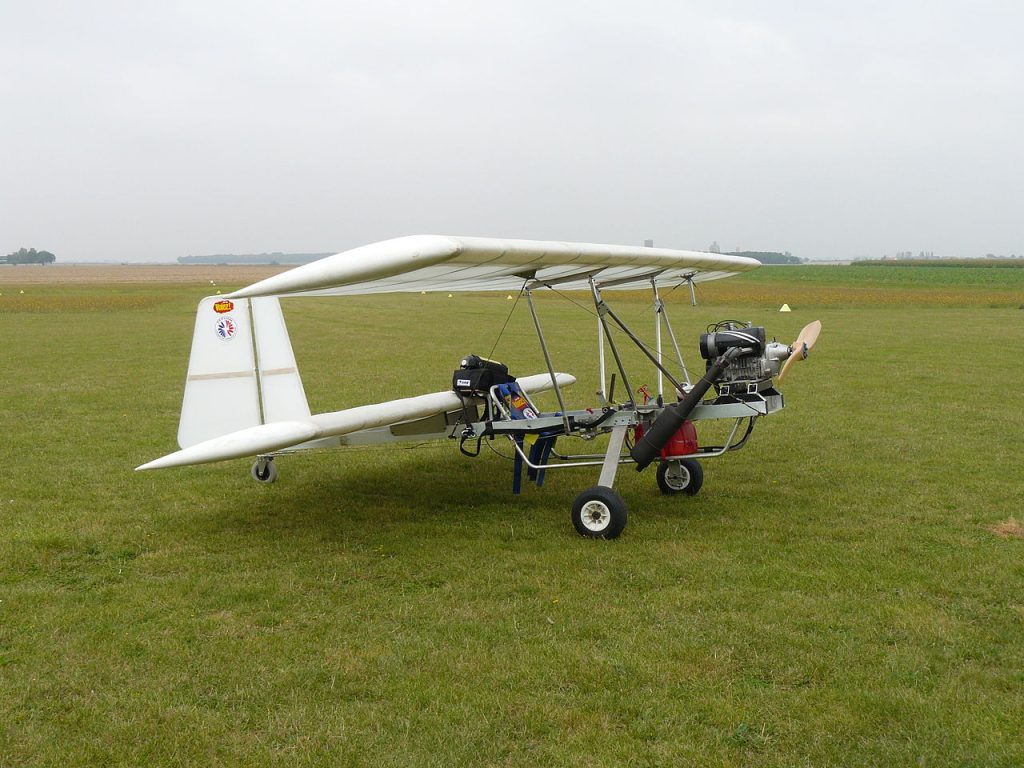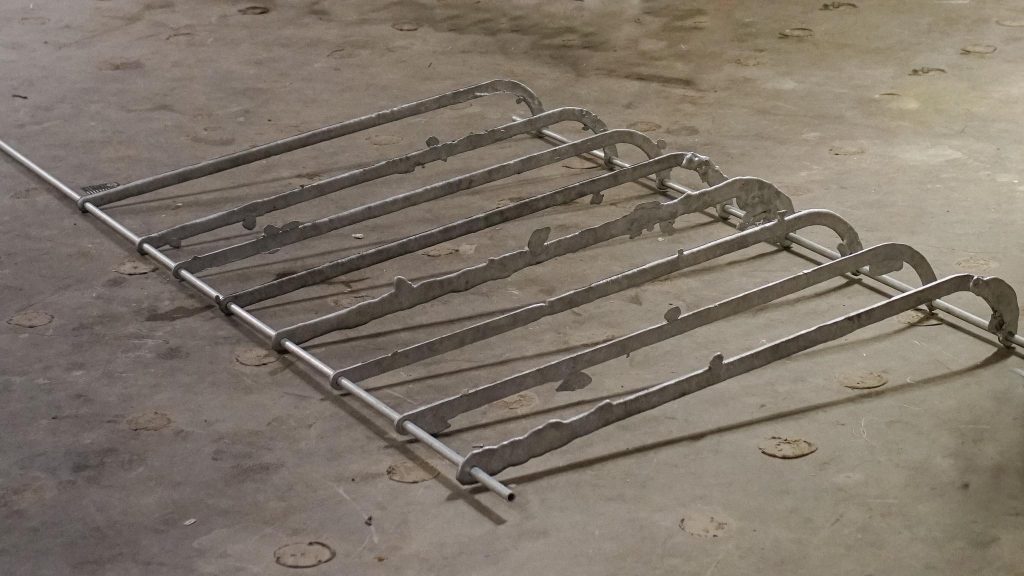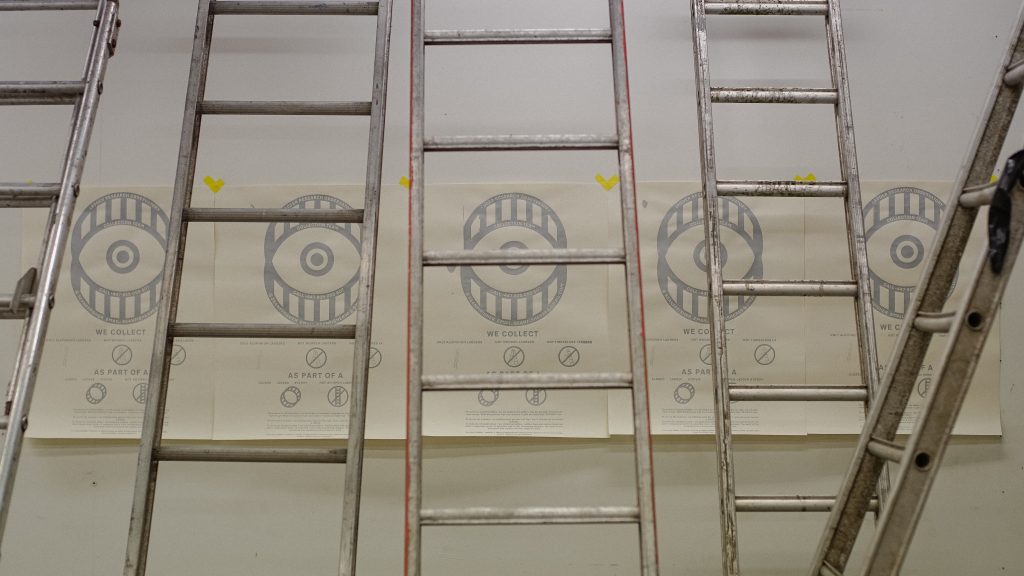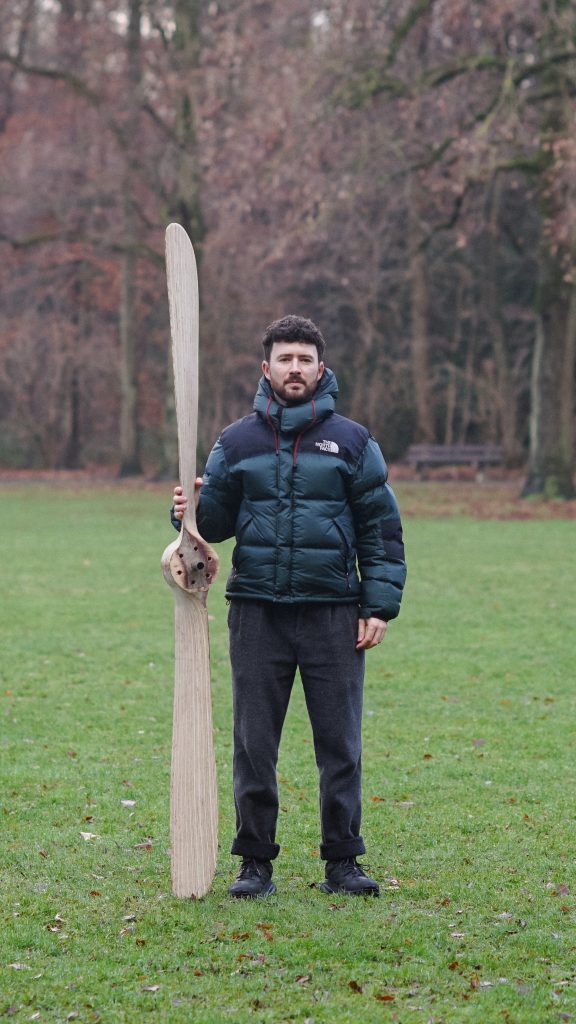Interview with Sean Fisher on his ladder plane
Author: Roosa Joensuu, Leonardo Times Editor
Sean Fisher is an artist with a background in engineering and recently graduated from Design Academy Eindhoven with a Master of Arts. Sean started building airplane parts out of molten ladders for his graduation project and is now slowly collecting material and casting parts with the support of the community he has built around ladders – “The Ladder Research Observatory”. The project entitled ‘My Second Plane’ dives into pataphysics – the science of imaginary solutions.
Q: What exactly is pataphysical engineering?
SF: I came up with the term pataphysical engineering when I did some research for my thesis. I discovered James Donohue, who attached an iMac G3 as a fairing to his bike to make it more aerodynamic, then I discovered Douglas Brooks trying to reinstate traditional boat craft back to life – a Tarai-buné is an old Japanese design of a bathtub turned into a boat. As an engineer, I was drawn to both objects because I couldn’t understand why people made them. These people weren’t testing or prototyping or going through any regulations beforehand, they just believed that it would work – and in a sort of pseudo-way, it does.
The third case study for my thesis was this plane with an aluminum ladder as the chassis. I never got a chance to interview the creator of this plane, Daniel Dalby, who is leading the Association for the Promotion of Flying Ladders. He ignored my calls and Facebook friend requests, so I became critical of his project and started to develop my own project around that time, ‘My Second Plane’.
Pataphysical engineering is a term I coined based on these three case studies. Each person is committed and believes in what they are doing. The difference to conventional engineering is that these things don’t have to exist for the real world, for efficiency or perfection. These are solutions for problems that don’t exist – yet. We don’t have to make planes out of ladders, boats out of tubs, or bicycle fairings out of old computers, but maybe, at some point, we will have to. Pataphysics is a concept developed by Alfred Jarry, it’s a pseudoscience, the science of imaginary solutions. As an artist, I think it is important to show the things that can’t be seen and to communicate those in an interesting way.
Q: What are you designing for your project, ‘My Second Plane’?
SF: I am designing an ultralight aluminum aircraft. When I researched Daniel Dalby’s ladder aircraft, I concluded that it was an open-system design. He has the financial means to attach parts to ladders to make them fly, instead of believing in ladders themselves as flying objects. I decided to make my own project a closed-loop system. I have to create the aircraft parts from the ladders.
A large part of this project relates to R. Buckminster Fuller’s Spaceship Earth theory: we are moving through the universe on this spaceship called planet Earth, and what we have here are the materials and resources available to us. We have to be careful with those materials and understand where they originate. I’m imitating this theory with my project: my world is essentially ladders. Whatever I make from the material can be turned back into ladders again.
I have given myself rules for designing: I can only use materials from ladders, I can use as many ladders as I want, and I have to design through observations without drawings.
Through designing from observations, the project emulates the starting point of the world. In the beginning we observed and tried things out – there were no guidebooks, plans or drawings, there was nothing available. You react to observations. In my project I can only use the material originating from the ladder, primarily aluminum. Although, sometimes, I use materials that may or may not be attached to the ladder, because… well, I can break my own rules.
Q: How have people responded to your project?
SF: At first, people come to me with furrowed brows, seeing bits of metal and they don’t understand it. I would talk to them or direct them to the video about the project. Then they start to understand, saying they love it and asking about the ideas behind it. They leave with creases around their mouth, laughing. In a way, I don’t even fully understand it myself. It’s just out of reach, where I like it to be, that keeps it exciting. I would like to see what happens if I keep pushing more.
I’m still building the plane; I collect ladders every week, and I have to say that one does tire of them. Now I’ve become “the ladder guy,” and people just send me photos of ladders. I’m still spreading the word, building the community and gathering people who can help me and who believe in the project. I would not have been able to do this without the support of others.


Q: You have a background in engineering. In your opinion, what could engineering education and industry learn from new design perspectives?
SF: I indeed had a Master’s in engineering before I obtained this Master of Arts. During the Covid-19 pandemic, the world turned around overnight by some unseeable virus, and it frightened me. Everything became absurd. I found comfort in these odd engineering objects I mentioned earlier because they didn’t really make sense either in a normal engineering sense.
Something that I think applies to engineering is that you should not let the past dictate the future. You can change things. Technology development should be encouraged but simultaneously looked at through a critical lens. I think we should embrace change and do things differently. We should experiment more and look at things for longer.
My project emulates the slow nature of building something termed degrowth. I’m doing this in a slow and labor-intensive way. I have to collect the ladders, melt them, cast them, and build parts myself – what I showed at the graduation looked like a scrapyard, but it was to highlight that we can do things at a much slower pace. If we slow down, everything will be fine – we just move more slowly. I think, in a way, that’s what we need to do. Technology does not need to come so quickly.
Q: What have you learned from this journey?
SF: I think the primary skill I’ve learned is building a community around such a banal object – a ladder is inherently a functional tool that we use. I had to generate a story and interest around this object, and I managed to grow quite a large team around ladders. I gained public’s trust, because they appreciate that I’m doing something with the ladders and not just selling them to the scrapyard.
In a way, I also had to learn not think like an engineer. After training for 5-6 years, it’s hard to switch out of that mindset. It’s difficult to try not to make things perfect and even to explore other mediums you can use to communicate in this creative environment. I’m trying to retain this strong engineering identity to inspire other engineers to illustrate that you can be a bit silly; it doesn’t have to be done by the book.
My advice for everyone would be to build something crazy! Even the initial idea of human flight came from looking at birds and trying to repeat that – that idea has since then developed into what we have today. There should be more copying weird things.
Q: What is your dream project?
SF: I can’t think of other projects because the more time I spend on this one, the more I want to complete it. It would be amazing to see this in a gallery space. Especially because it’s a community-led absurd task. We’re not trying to save the planet; we’re trying to make people’s day. We’re collecting ladders and using them to build a plane – that’s a weird thing to happen to someone. It’s fun to be a part of that at the end of the day.
I think many changes in the world can be done on a microscale – just changing people’s mindsets on that day or even in that hour. It doesn’t have to be a grandiose societal shift in an instant, it can be just a small conversation with a guy collecting a ladder for his plane. In that instance, talking about what he’s doing and what his values are could inspire you. These projects are just a way of seeing things. This project reflects how I look at the world – you can look at it like that for a bit with me, but you don’t have to.
CONCLUSION
At Leonardo Times, we would like to thank Sean for his interview. If you want to learn more about his project, you can look at the website using the following QR code.


